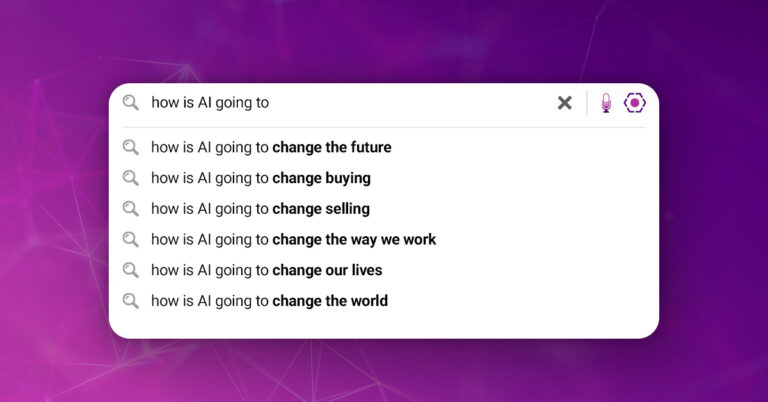Transitioning from the traditional, siloed marketing approach to an integrated marketing strategy can be daunting. The B2B buying landscape is evolving rapidly. And marketing leaders are wondering if they’re doing everything they can to reach their target audiences and help them progress along their journey.
In this blog, I’ll share five key aspects of a successful integrated marketing strategy. But first, let’s look at what integrated marketing means, and why this approach is so important for B2B marketing right now.
What is integrated marketing?
Integrated marketing is the orchestration of the messaging and content used in campaigns across all the channels your prospects use, both digital and physical. For this reason, integrated marketing is also sometimes called omnichannel marketing. The goal of integrated marketing is to create a consistent experience everywhere customers interact with your brand.
The north star of integrated marketing is a unified conversation that propels buyers toward deeper and deeper engagement with your brand.
Don’t confuse integrated or omnichannel marketing with multi-channel marketing, where every touchpoint operates in a silo. Integrated marketing is a holistic approach, where marketing and sales teams work together to make sure you’re creating a cohesive buyer’s journey across touchpoints.
What does that look like? Imagine you’re a procurement manager at a manufacturing company and you’re looking for a new supplier of raw materials. You come across an online article about sustainable sourcing practices, written by a local materials supplier. As you search for more information, you start seeing ads from that supplier offering eco-friendly materials – exactly what you were looking for originally.
You visit their website, where you find a list of sustainability certifications and a case study on how they helped another company reduce their environmental impact. You schedule a meeting with their sales team, who ask if you have any questions about the materials you’d already been researching or related sustainability practices.
It’s easy to see how the supplier’s integrated approach created a unified conversation that helped the procurement manager learn about and evaluate relevant solutions—and ultimately engage in a sales meeting.
Why is integrated marketing necessary for B2B?
Today’s B2B buyers expect to discover, learn about, evaluate, and even purchase B2B solutions in a largely self-service manner. They typically engage in an astounding 27 interactions before buying, across 10 or more channels. These interactions are likely spread across multiple members of a buying team which, for enterprise purchases, can consist of 6-10 individuals with different needs and goals, and distinct watering holes, based on their roles.
If you’re not in those channels with a consistent message and relevant content, you’re not only missing an opportunity to influence your target audiences, you’re likely leaving a vacuum that your competitors can easily step into.
5 common mistakes that can derail your integrated marketing strategy (and what to do instead.)
The companies that win and grow in this complex buying landscape are those that make it effortless for potential buyers to progress along their journey. Here are five common problems to watch out for as you transition to or optimize your integrated marketing strategy.
1. STOP skipping deep marketing and sales alignment and START agreeing on goals, metrics, and more from the start.
The most important thing for your integrated marketing strategy is to ensure there’s continuity between marketing and sales teams. This means making sure that everyone in both organizations deeply understand:
- The goals and objectives of your program or campaign
- The metrics you will use to measure progress toward those goals and objectives
- What your systems of record will be to pull those metrics
- Which specific reports and dashboards you will use from those systems
If teams fail to establish clarity all the way down to the level of reporting, even minor variations in assumptions—like the report’s timeline—can lead to larger mistakes. As the number of systems you use increases, so do the chances of encountering these kinds of misinterpretations. This is especially important in integrated marketing, where utilizing data effectively is critical to maintaining a competitive advantage. It could make all the difference between a campaign that performs exceptionally well and one that falls flat.
2. STOP targeting the wrong people and/or the wrong channels and START narrowing down your list of job titles and exactly where they hang out.
Focus your media efforts on getting your message in front of the right job titles from companies matching your ICP.
When Marketing’s demand gen initiatives fail to attract the individuals that Sales wants to engage with, everyone’s time and resources have been wasted. Unlike broad-based demand campaigns that concentrate on general-use channels, such as Facebook or Taboola, to reach as many prospective buyers as possible, ABM campaigns should center on getting your message to the relevant job titles within companies that align with your ICP.
Begin by narrowing down the job titles that have the highest level of influence over the buying group at your target accounts. Intent providers like TechTarget and 6Sense can be incredibly helpful in pinpointing individuals who are actively consuming content that relate to the issues your solution resolves, as well as identifying the titles that have been most likely to convert in the past. It’s critical to collaborate closely with Sales to ensure that the job titles you’re focusing on are the ones that they’re interested in talking to. Otherwise, all of this work is for nothing.
Next, concentrate your paid media budget on the platforms where those job titles hang out. There are lots of ways to do this, such as displaying ads in LinkedIn’s affinity groups, collaborating with niche publishers, and employing resources like Metadata to help you target specific audiences within those larger channels. Make sure your plan incorporates evaluating who is responding to your ad campaigns and retargeting those who fit your ICP and target account criteria with increasingly deeper and pertinent content.
(See how we applied these principles to a rapid response, thought leadership campaign and reached more than 400 targeted accounts—with a 20% opt-in rate for new prospects to be contacted by our customer.)
3. STOP relying on one-size-fits-all content and START helping buyers with full-funnel, humanized content.
Narrowing your target audience is not solely about reaching the right people, but also making sure your content is genuinely helpful and applicable to them. Just bringing them to your website isn’t enough. If your content doesn’t help them solve their problems, they won’t continue their journey with your company.
Once you’ve identified the job titles that are most likely to be involved in and impact the purchasing decision, take the time to develop detailed personas for those titles, including their everyday pain points and motivations, their role on the buying team and what their buyer’s journey entails.
We cannot stress this last part enough. Many marketers make the mistake of over-indexing on generating interest and neglecting the task of maintaining and growing that interest. B2B buyers want ways to perform their jobs more effectively. This necessitates a full-funnel, humanized content strategy that helps buyers:
- Gain awareness of and understand the problem your solution addresses
- Understand what solutions are available that can solve the problem
- Evaluate those solutions thoroughly
- Buy, implement and optimize those solutions
4. STOP giving Sales leads without context and START communicating data about your prospects.
One of the many advantages of putting journey stage-specific information in front of a highly specific audience is that their consumption data provides valuable insights into their position in the buyer’s journey. Are they consuming a lot of content about the problems that your solution addresses? They are likely in the market for a solution like yours. Consuming middle-of-the-funnel content, such as webinars and white papers? They are likely moving closer to a purchasing decision.
Monitoring this data is an excellent way to understand how your particular audience makes purchasing decisions. With that information, you can determine the ideal timing, approach, and offers for your sales team to intercept that audience. As the holders of this information, it is crucial for Marketing to ensure that Sales gets what the prospect and account have already accomplished and has enough flexibility in their sales strategy to meet the prospect where they are rather than restarting the process.
5. STOP overlooking testing and optimization and START employing multivariate testing.
Multivariate testing, such as A/B testing, is a must when targeting multiple personas at different stages of the buying journey. You’ll be able to identify the most effective imagery, messaging, content, channel, and CTA placement for each audience quickly.
An often-overlooked factor is what happens after that initial click. Ad clicks are a useful metric for assessing the ad’s effectiveness—in driving clicks. But a purchase is more than an ad click. You have to consider what happens to those prospects after they arrive on your website. Does the click become a lead, an MQL (or MQA or, even better, a Marketing Qualified Opportunity), an SQL, opportunity, and ultimately, closed-won revenue?
The Iron Horse insight.
An integrated marketing approach has the potential to create real value for the organization. Its success depends on marketing and sales teams working together as a single team focused on a single outcome. Embracing this way of thinking is the single best thing your organization can do to create the personalized, self-serve experiences B2B buyers want, shorten the sales cycle, and drive sustained growth.



